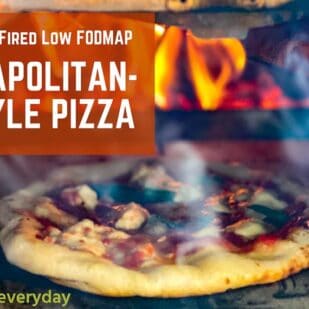
Wood-Fired Low FODMAP Neapolitan-Style Pizza
This Wood-Fired Low FODMAP Neapolitan-Style Pizza does require a wood-fired oven that reaches temperatures of at least 900°F (482°C) – I use an Ooni Pro - as well as very specific ingredients. I know that all of you don’t have a cooking source like this available, but for those who do, I wanted to bring you a version of a wood-fired low FODMAP pizza. This dough is based on a long, 3-day fermentation period, FYI, so you have to plan ahead. As with any recipe, read this through before starting.
Low FODMAP Serving Size Info: Makes 4 pizzas; approx. 8 servings depending on toppings; 1/2 pizza per serving
Ingredients:
Pizza Dough:
- 17.6- ounces (500 g) Caputo 00 Pizzeria Flour (blue bag), plus extra
- ¼ teaspoon instant dry yeast, such as SAF brand
- 1 2/3 cups (405 ml) warm water, 120°F to 125°F (48°C to 52°C)
- 2 teaspoon salt
Sauce & Toppings:
- 2 cups (480 ml) Low FODMAP Pizza Sauce
- 1- pound (445 g) fresh mozzarella in brine, drained and torn
- Fresh basil leaves
- Extra virgin olive oil
Preparation:
-
For Making By Hand: Whisk together the 17.6-ounces (500 g) of flour and instant yeast in a large bowl to aerate and combine. Dissolve salt in the warm water, slowly add to the dry mixture and begin to stir together with a sturdy wooden spoon until a wet dough forms, then beat vigorously until mixture looks like a firm, somewhat moist batter with a little elasticity.
-
For Making With A Stand Mixer: Place the 17.6-ounces (500 g) of flour and instant yeast in stand mixer bowl fitted with flat paddle or dough hook attachment and mix on low to aerate and combine. Dissolve salt in the warm water, slowly add to the dry mixture with machine on low-medium speed beating until a wet dough forms, then turn speed up to medium to medium-high and beat until mixture looks like a firm, somewhat moist batter with a little elasticity.
-
Very lightly coat a bowl or container with olive oil, scrape the dough into the receptacle and turn the dough around to coat with oil. Seal the bowl with plastic wrap, or snap on a cover to the container.
-
Let sit at warm room temperature for 2 hours then unmold onto work surface. Divide into four equal pieces, round them off, creating smooth domed tops, tucking edges underneath. Place in individual container or one large container, either way allowing room for growth. Very lightly coat with oil, seal container (s) and refrigerate for 72-hours.
-
Remove from refrigerator at least 4 hours before cooking pizzas, leaving covered.
-
Preheat oven according to manufacturer’s instructions to 900°F (482°C). The deck should be this hot. Have your toppings prepped.
-
Lightly flour your work surface. Working with one ball of dough at a time (keeping others covered) start to pat out the dough using your fingertips. You always want to be working from the middle going outwards and you want to preserve the edge – your cornicione. Do not flatten the edge. Keep flattening and stretching until your dough is about 10-inch to 12-inches (25 cm to 30.5 cm) across. You should be able to do this with your hands; no rolling pin needed.
-
Scatter extra flour on your wooden peel. Now you have a choice. Top your pizza before you move it to the peel, or after. Many pros do it before; you might find it easier to do after. Either way when you do move the raw dough to the peel, take a moment to re-shape it and make it as pleasingly round as possible.
-
To Top with Pizza Sauce, start with about 1/3 cup (75 ml). Starting in the center and moving outward begin spreading it with the bottom, rounded surface of a large spoon, leaving the edges of the crust bare. Scatter cheese on top. Add a few fresh basil leaves, a drizzle of olive oil, and launch into the oven.
-
Have your turning peel handy and about 5 to 10 seconds after launch begin to slide the peel under the pizza and begin to move it around and turn it around. Monitor it constantly. Do not try to pat out the next pizza at the same time!
-
You want the pizza to be golden here and there, spotted with some char here and there. The bottom should be cooked thoroughly, and the toppings should also be hot and cooked through. Total cooking time 60 to 90 seconds.
-
Serve immediately and repeat with remaining dough and toppings.
Notes:
FODMAP Information
Our recipes are based on Monash University and FODMAP Friendly science.
• Canned Tomatoes: Monash University has lab tested canned tomatoes and they are low FODMAP at 92 g or 3.2-ounces, which they say is about 3/5 of a cup. Moderate FODMAPs kick in at about 3/4 cup or 115 g, at which point fructose can become an issue.
• Cheese: Many cheeses have low FODMAP serving sizes. The low FODMAP diet is not a dairy-free diet. Hard cheeses such as Parmigiano Reggiano or Pecorino Romano have been lab tested by Monash University and are low FODMAP in 40 g amounts.
• Oil: All pure oils are fats and contain no carbohydrates, therefore they contain no FODMAPs.
• Yeast: Yeast – fresh, dry and instant – are all low FODMAP.
Please always refer to the Monash University & FODMAP Friendly smartphone apps for the most up-to-date lab tested information. As always, your tolerance is what counts; please eat accordingly. The ultimate goal of the low FODMAP diet is to eat as broadly as possible, without triggering symptoms, for the healthiest microbiome.